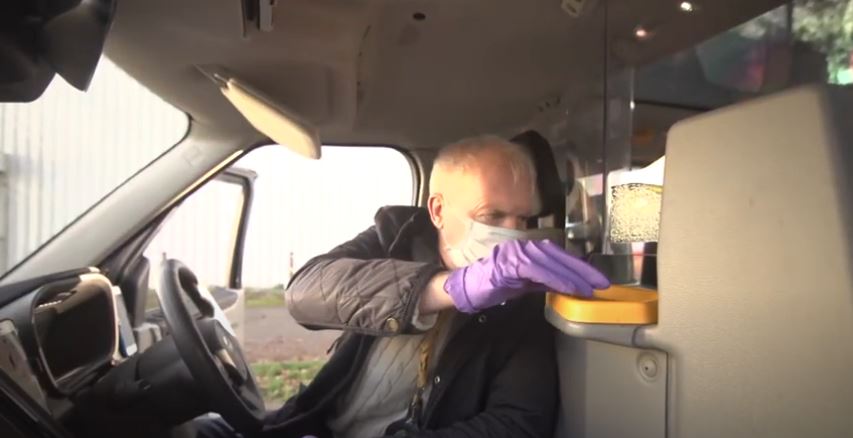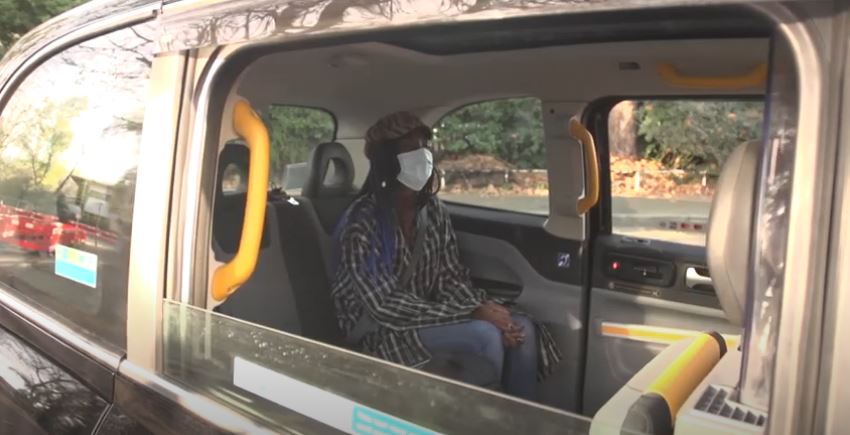
London, UK – Transport for London (TfL) have released a new video accompanied by detailed advice on the best ways to stay safe from the coronavirus for both driver and passenger.
After each journey, taxi and private hire drivers are advised to prepare their vehicle for the next passenger.
This video has been created by TfL specifically for taxi and private hire licensees to demonstrate how to effectively and efficiently clean their vehicle to keep themselves and their passengers safe.
Coronavirus is carried in the air by tiny droplets. Larger droplets can land on surfaces they touch. Smaller droplets can stay in the air for at least five minutes and often much longer if there is no ventilation.
Because of the risk of coronavirus being on surfaces in a vehicle after you’ve dropped off a passenger, there are also a variety of cleaning procedures that you should do before you pick up a new passenger.
These include using your onboard sanitizing product to wipe clean any surfaces that your customers may have touched while inside the vehicle.
Before you start, they say it is important that you find a safe environment to park your vehicle, where you can safely move around the outside of it without any risk to yourself or others.
They recommend making sure you’re wearing protective gloves and a face covering, and that you’re in a well-ventilated area. Your anti-microbial product should be applied using a trigger spray bottle and fresh rags or paper cloth that should be disposed of after use. They should be wrapped in a plastic bag and disposed of in general waste.
Cleaning products
They say that for disinfection, diluted household bleach solutions (hydrogen peroxide or sodium hypochlorite), alcohol solutions with at least 60% alcohol, and certain anti-viral household disinfectants should be effective. Regular detergent and diluted bleach are fine for combating coronavirus. If you are buying disinfectant, check the product information to make sure it says it combats enveloped viruses including influenza and human coronaviruses.
Cleaning tips
Starting on the outside of your vehicle, they advise beginning by cleaning all door handles that have been used, and the handle for the boot, if it has been used. Then clean the interior surfaces that the passenger may have come into contact with, including:
- Window controls
- Door handles
- Internal grab handles
- Seats, seatbelts and clips
- Light switches
- Payment terminal, if you have one.
All taxis are fitted with a permanent partition and some private hire vehicles now have a temporary partition screen. If there is a partition in your vehicle, this should also be properly cleaned.
End of shift
At the end of your shift, they reiterate that there are other areas that you should also clean in addition to the ones already mentioned – these are the surfaces that only you (the driver) are likely to have come into contact with. They are as follows:
- The steering wheel and related controls
- Your keys
- Any buttons (including radio and heating or A/C controls)
- Rear-view mirror adjuster
- Handbrake lever or button
- Gearstick
- Visors.

When you have finished cleaning your vehicle, you should keep the doors or windows open for 5 minutes to make sure it’s properly ventilated. You should then wash your hands for a full 20 seconds or use hand sanitizer.
Cleaning services
They state that you may also wish to consider using a company that provides professional cleaning services to have your vehicles cleaned.
If you decide you want to get your vehicle cleaned professionally, here are some questions that you may wish to consider or ask companies offering this service to help you decide which to choose:
- Ask the company if the cleaning products they use are effective against enveloped viruses
- Ask how long the cleaning products they use protect surfaces for and if they have evidence of this
- Confirm that the cleaning products are safe to use on all surfaces (eg leather, rubber seals, etc.)
- Once a vehicle has been cleaned ask how long you have to wait before you can drive it and it is safe for passengers to travel in it
- Ask what actions or cleaning products should or should not be used after a professional clean.
Personal protective equipment – Face coverings for passengers
Passengers must wear a face covering in a taxi or PHV, unless they are exempt. You can refuse to take a passenger if they are not wearing a face covering, and they could be fined.
Face coverings for licensees
Taxi and private hire drivers are expected to wear face coverings at all times when in their taxi or private hire vehicle.

This remains the case, unless you have a valid exemption. This is an important safety measure to protect licensees, passengers and wider society.
Providing PPE to licensees
As previously reported by TaxiPoint, on 4 December TfL announced an initiative to support the recovery of the taxi and private hire industry from the impact of the pandemic.
Alongside the instructional video, for a limited period, TfL are making PPE available to licensees, including 1.5 million face coverings, 30,000 bottles of Dettol hand sanitizer and customer-facing stickers to be displayed in licensed vehicles.
These materials are available to licensees at a number of sites across London from Monday 7 December.
Safely operating TPH services
It is important to wash or sanitize your hands if you come into contact with a passenger or their luggage. You should do this before and after contact.
You must continue to provide support to disabled passengers to safely enter and exit your vehicle and assist with their luggage and/or mobility equipment if required.
You should ask passengers to sit as far from you as possible. Passengers should not sit in the front seat of a private hire vehicle.
Open windows when carrying passengers and/or use the car’s vents to bring in fresh air from outside. You should not use the recirculated air option for the car’s ventilation system when carrying passengers.

Passengers should be reminded to wash or sanitize their hands after the journey. You should endeavour to take contactless payment wherever possible. If this is not possible, then you should wash your hands with soap and water or use sanitizer after handling money.
PHV operators and taxi apps should provide information on hygiene and relevant information to passengers via smartphone apps, text messages and any other relevant means of communication (email etc) before the journey commences.
Operators and taxi apps should also:
- Encourage drivers to read the latest guidance from GOV.UK and keep up to date with the latest TPH notices and bulletins
- Display posters to remind drivers and passengers of good hygiene practices
- Encourage passengers to download and use the NHS COVID-19 track and trace app
- Remind passengers of social distancing rules when they make a booking, make it clear that passengers must wear a face covering at all times when in the vehicle, unless they are exempt
- Remind passengers to wash their hands for at least 20 seconds or use hand sanitizer before entering the vehicle.
Follow us on our Facebook and Twitter pages for the latest stories, products & updates.




















